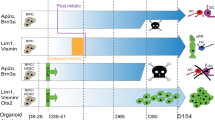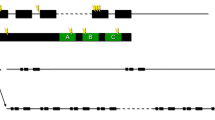Abstract
Retinoblastoma (RB) tumours form in the eyes of young children when homozygosity for a mutation at the Rb-1 locus develops in a somatic retinal cell1,2. A similar shift to homozygosity for the RB mutation has been observed in osteogenic sarcoma (OS) tumours that commonly arise as second tumours in children who survive RB3. This observation suggests that the Rb-1 locus controls the expression of genes with oncogenic potential; a possible target is the oncogene N-myc, which is sometimes amplified and over-expressed in the neuroectodermal tumours neuroblastema4–7 and RB5–8. However, N-myc is developmentally regulated in normal murine embryogenesis9, and an alternative possibility is that the expression of the gene in tumour cells reflects their embryonic origin and is unrelated to the RB mutation. We have therefore examined N-myc expression in various fetal, adult and tumour tissues, and report here that the gene is expressed in fetal but not in adult brain and retina and in near-diploid RB tumour samples at levels similar to those observed in normal fetal retina. Only RB tumours with genomic amplification of the N-myc gene exhibited increased levels of expression; and no N-myc transcripts were detected in osteogenic sarcomas initiated by mutations at the Rb-1 locus3. We therefore conclude that the expression of N-myc in RB tumours probably reflects the origin of the tumour from an embryonic tissue normally expressing the gene and is not directly associated with the mutation at the RB locus.
Similar content being viewed by others
References
Cavenee, W. K. et al. Nature 305, 779–784 (1983).
Cavenee, W. K. et al. Science 228, 501–503 (1985).
Hansen, M. F. et al. Proc. natn. Acad. Sci. U.S.A. 82, 6216–6220 (1985).
Kohl, N. E., Gee, C. E. & Alt, F. W. Science 226, 1335–1337 (1984).
Schwab, M. et al. Proc. natn. Acad. Sci. U.S.A. 81, 4940–3944 (1984).
Schwab, M. et al. Nature 305, 245–248 (1983).
Kohl, N. E. et al. Cell 35, 359–367 (1983).
Lee, W.-H., Murphree, A. L. & Benedict, W. F. Nature 309, 458–460 (1984).
Jakobovits, A., Schwab, M., Bishop, J. M. & Martin, G. R. Nature 318, 188–191 (1985).
Comings, D. E. Proc. natn. Acad. Sci. U.S.A. 70, 3324–3328 (1973).
Thiele, C. J., Reynolds, C. P. & Israel, M. A. Nature 313, 404–406 (1985).
Sakai, K. et al. Cancer Genet. Cytogenet. 17, 95–112 (1985).
Nau, M. M. et al. Nature 318, 69–73 (1985).
Seeger, R. C. et al. New Engl. J. Med. 313, 1111–1116 (1985).
Brodeur, G. M., Seeger, R. C., Schwab, M., Varmus, H. E. & Bishop, J. M. Science 224, 1121–1124 (1984).
Reid, T. W. et al. J. natn. Cancer Inst. 53, 347–360 (1974).
Cleveland, D. W., Pittenger, M. F. & Feramisco, J. R. et al. Nature 305, 738–740 (1984).
Squire, J. et al. Proc. natn. Acad. Sci. U.S.A. (in the press).
Varki, A., Muchmore, E. & Diaz, S. Proc. natn. Acad. Sci. U.S.A. 83, 882–886 (1986).
Becker, L. E. & Hinton, D. Hum. Path. 6, 538–550 (1983).
Zimmerman, K. A. et al. Nature 319, 780–783 (1986).
Abramson, D. H., Ellsworth, R. M., Kitchen, F. D. & Tung, G. Ophthalmology 91, 1351–1355 (1984).
Squire, J., Gallie, B. L. & Phillips, R. A. Hum. Genet. 70, 291–301 (1985).
Maniatis, T., Fritsch, E. F. & Sambrook, J. Molecular Cloning: A Laboratory Manual (Cold Spring Harbor Laboratory, New York, 1982).
Southern, E. M. J. molec. Biool. 98, 503–517 (1975).
Rigby, P. W. J., Dieckmann, M., Rhodes, C. & Berg, P. J. molec. Biol. 113, 237–251 (1977).
Chirgwin, J. M., Pryzbyla, A. E., MacDonald, R. J. & Rutter, W. I. Biochemistry 18, 5294–5299 (1979).
Church, G. M. & Gilbert, W. Proc. natn. Acad. Sci. U.S.A. 81, 1991–1995 (1984).
Author information
Authors and Affiliations
Rights and permissions
About this article
Cite this article
Squire, J., Goddard, A., Canton, M. et al. Tumour induction by the retinoblastoma mutation is independent of N-myc expression. Nature 322, 555–557 (1986). https://doi.org/10.1038/322555a0
Received:
Accepted:
Issue Date:
DOI: https://doi.org/10.1038/322555a0
- Springer Nature Limited
This article is cited by
-
MYCN gene expression is required for the onset of the differentiation programme in neuroblastoma cells
Cell Death & Disease (2014)
-
Expression of MYCN in pediatric synovial sarcoma
Modern Pathology (2007)
-
Murine bilateral retinoblastoma exhibiting rapid-onset, metastatic progression and N-myc gene amplification
The EMBO Journal (2007)
-
How do retinoblastoma tumours form?
Eye (1992)





